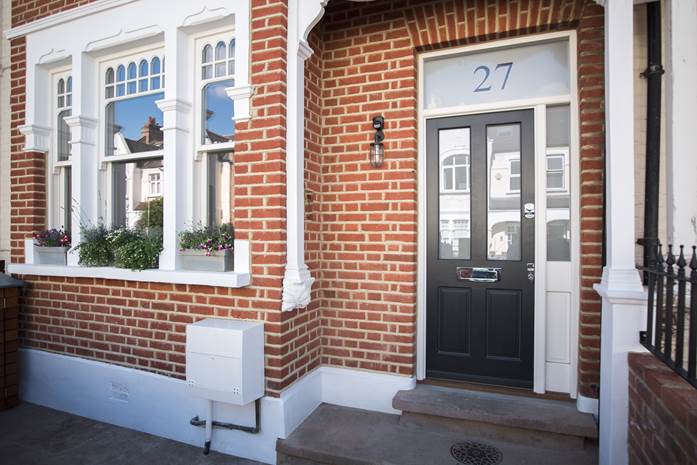
How to paint your front door

A Step-by-Step Guide: Painting Your Timber Front Door Using Micro Porous Paint
Introduction:
Painting your timber front door not only enhances its appearance but also protects it from weather elements. In this blog post, we will guide you through the process of painting your timber front door using micro porous paint. Micro porous paint allows the timber to breathe while providing a durable and long-lasting finish. So let's get started!
Materials Needed:
1. Micro porous paint (specifically designed for timber)
2. Paintbrushes (one large, one small for detailed work)
3. Sandpaper (medium and fine grit)
4. Dust mask
5. Painter's tape
6. Drop cloth or old sheets
7. Paint tray or container
8. Primer (if required)
9. Cleaning solution (mild detergent and water)
10. Sponge or cloth
11. Optional: wood filler and putty knife (if there are any dents or holes to repair)
Step 1: Prepare the Door
a. Start by removing any hardware such as doorknobs, hinges, and letterboxes. This will make the painting process easier and ensure a neat finish.
b. Place a drop cloth or old sheets under the door to protect the surrounding area from paint drips.
c. Clean the door surface using a mild detergent and water solution. Remove any dirt, dust, or grease. Rinse with clean water and allow it to dry completely.
Step 2: Sand the Door
a. Use medium-grit sandpaper to lightly sand the entire door surface. This helps remove any existing finish, smooth out imperfections, and create a better surface for paint adhesion.
b. Follow up with fine-grit sandpaper to achieve a smoother finish.
c. After sanding, wipe the door with a damp cloth or sponge to remove any dust.
Step 3: Repair Any Damages
a. If there are any dents, scratches, or holes in the door, use wood filler to repair them. Follow the manufacturer's instructions for the wood filler application and drying time.
b. Once the wood filler is dry, sand the repaired areas lightly to make them flush with the door surface.
Step 4: Apply Primer (if necessary)
a. Check the instructions on your chosen micro porous paint. Some brands may require a primer, while others may not.
b. If a primer is needed, apply it to the door following the manufacturer's instructions. Priming helps enhance paint adhesion and improves the durability of the finish.
c. Allow the primer to dry completely before proceeding to the next step.
Step 5: Start Painting
a. Stir the micro porous paint thoroughly using a paint stick or stirrer.
b. Start painting the door using a large paintbrush. Begin with the recessed or molded areas first, then move on to the flat sections.
c. Apply the paint evenly, using smooth and consistent strokes. Paint in the direction of the wood grain for a professional look.
d. If needed, use a smaller brush for more intricate details or hard-to-reach areas.
e. Let the first coat dry completely, following the drying time specified by the manufacturer.
Step 6: Apply Additional Coats
a. Depending on the desired color and finish, you may need to apply additional coats. Follow the manufacturer's instructions regarding the recommended number of coats.
b. Before applying the next coat, lightly sand the door with fine-grit sandpaper to create a smooth surface for better paint adhesion.
c. Repeat the painting process for each additional coat, allowing sufficient drying time between coats.
Step 7: Finishing Touches
a. Once the final coat is dry, inspect the door for any uneven areas or drips. If necessary,
Introduction:
Painting your timber front door not only enhances its appearance but also protects it from weather elements. In this blog post, we will guide you through the process of painting your timber front door using micro porous paint. Micro porous paint allows the timber to breathe while providing a durable and long-lasting finish. So let's get started!
Materials Needed:
1. Micro porous paint (specifically designed for timber)
2. Paintbrushes (one large, one small for detailed work)
3. Sandpaper (medium and fine grit)
4. Dust mask
5. Painter's tape
6. Drop cloth or old sheets
7. Paint tray or container
8. Primer (if required)
9. Cleaning solution (mild detergent and water)
10. Sponge or cloth
11. Optional: wood filler and putty knife (if there are any dents or holes to repair)
Step 1: Prepare the Door
a. Start by removing any hardware such as doorknobs, hinges, and letterboxes. This will make the painting process easier and ensure a neat finish.
b. Place a drop cloth or old sheets under the door to protect the surrounding area from paint drips.
c. Clean the door surface using a mild detergent and water solution. Remove any dirt, dust, or grease. Rinse with clean water and allow it to dry completely.
Step 2: Sand the Door
a. Use medium-grit sandpaper to lightly sand the entire door surface. This helps remove any existing finish, smooth out imperfections, and create a better surface for paint adhesion.
b. Follow up with fine-grit sandpaper to achieve a smoother finish.
c. After sanding, wipe the door with a damp cloth or sponge to remove any dust.
Step 3: Repair Any Damages
a. If there are any dents, scratches, or holes in the door, use wood filler to repair them. Follow the manufacturer's instructions for the wood filler application and drying time.
b. Once the wood filler is dry, sand the repaired areas lightly to make them flush with the door surface.
Step 4: Apply Primer (if necessary)
a. Check the instructions on your chosen micro porous paint. Some brands may require a primer, while others may not.
b. If a primer is needed, apply it to the door following the manufacturer's instructions. Priming helps enhance paint adhesion and improves the durability of the finish.
c. Allow the primer to dry completely before proceeding to the next step.
Step 5: Start Painting
a. Stir the micro porous paint thoroughly using a paint stick or stirrer.
b. Start painting the door using a large paintbrush. Begin with the recessed or molded areas first, then move on to the flat sections.
c. Apply the paint evenly, using smooth and consistent strokes. Paint in the direction of the wood grain for a professional look.
d. If needed, use a smaller brush for more intricate details or hard-to-reach areas.
e. Let the first coat dry completely, following the drying time specified by the manufacturer.
Step 6: Apply Additional Coats
a. Depending on the desired color and finish, you may need to apply additional coats. Follow the manufacturer's instructions regarding the recommended number of coats.
b. Before applying the next coat, lightly sand the door with fine-grit sandpaper to create a smooth surface for better paint adhesion.
c. Repeat the painting process for each additional coat, allowing sufficient drying time between coats.
Step 7: Finishing Touches
a. Once the final coat is dry, inspect the door for any uneven areas or drips. If necessary,


